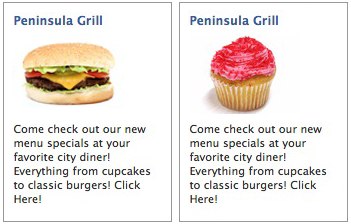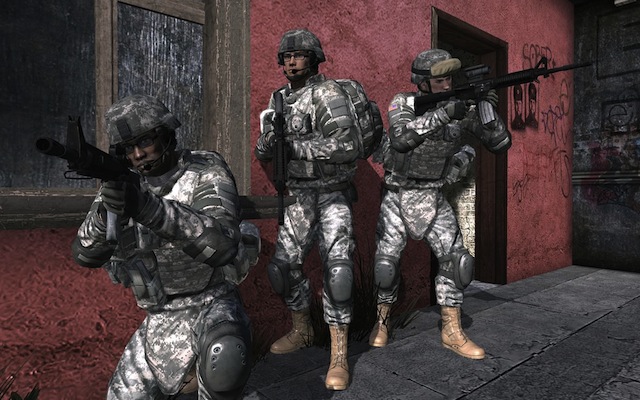A social media campaign created by Starbucks
Summary: After recently looking at Starbucks social media campaign I wanted to explore their strategy further. Throughout this blog I will be analysing how they responded to challenges, identifying all the CARAT elements, what research they carried out in the process and questioning whether or not the campaign brought the brand success.
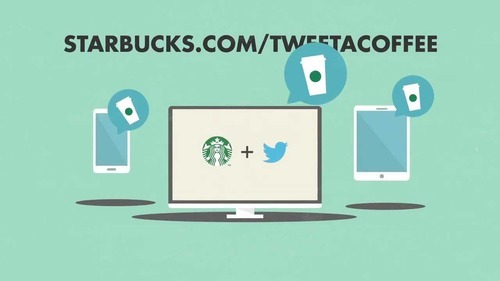
How It All Started
There’s no denying that Starbucks understands technology, and more importantly, their customers. On the 28th October 2013 Starbucks partnered with twitter to launch their ‘Tweet-a-Coffee’ campaign across the US. The initial idea was all about buying anyone, anywhere (well within the US) a coffee as a small gesture of kindness, and according to Adam Brotman, the chief digital officer at Starbucks, Twitter had the strength to help them achieve this.
In order for the campaign to work users had to link their Starbucks and credit card account to their twitter profile, then by tweeting @tweetacoffee with a friends twitter handle attached, an eGift worth $5 was sent to their desired recipient.
The Ultimate Challenge
Enticing the public to participate in a social media campaign is harder than one may think, so Starbucks needed to find a bigger incentive than just the element of gifting to another to get us stubborn lot involved. Not many of us like to do something for nothing these days so Starbucks stated that from the launch date until November 6th if you were one of the first 100,000 customers to ‘Tweet-a-Coffee’ using a visa card, you also got a $5 gift voucher as well as your friend. According to Keyhole this resulted in 32% of purchases occurring within the first day of launch, but how did Starbucks find the answer to this once impossible challenge?
The CARAT Process Was The Key
A process that makes the impossible challenges possible.
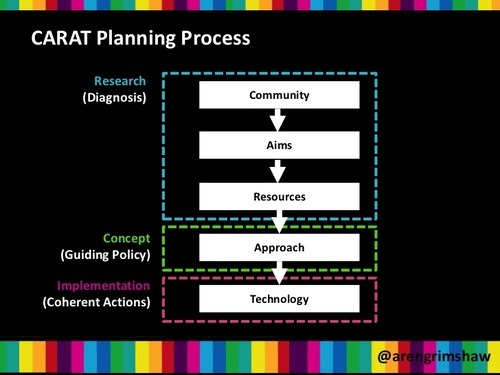
It’s All About The Research!
Who’s Involved In The Starbucks Community?
Target Market
Almost half of Starbucks’ total business comes from its primary target market of men and women aged 25 to 40, it’s this group alone that account for almost half (49 percent) of the brands total business. I believe for this campaign especially this target market were Starbucks most desired as people of this age are more likely to be cardholders and active on social media. These customers tend to be professional urbanites with relatively high incomes, who are interested in socially responsible and environmentally friendly policies. They consider the Starbucks logo as a status symbol and want to be associated with it.
Influencer
This campaign is reliant on influencers; friends, family and followers on Twitter. The influencers are the individuals who initially get the ball rolling, driving the campaign by sharing and gifting friends, ultimately encouraging them to do the same with others or to return the favour.
Partner
Twitter and Starbucks have worked together to help bridge the gap between our online and offline worlds, this is something beneficial for both brands. It’s a great opportunity for Twitter to become a direct response marketing channel while Starbucks now has information for all their gifters and recipients in their system, which could have massive longer-term impact on the ROI of this campaign.
What Are Starbucks Aiming For?
- An engaging campaign that customers wanted to interact with.
- Enticing new and existing customers to be more active or to set up an online account with their brand.
- Bridging the gap between our online and offline lifestyles meanwhile connecting multiple people across the US.
All of which fits in with their customer mission statement:
‘When we are fully engaged, we connect with, laugh with, and uplift the lives of our customers – even if just for a few moments. Of course, it starts with the promise of a perfectly made beverage, but our work goes far beyond that. It’s really about human connection.’
What Were The Resources?
The Bucks Budget
In 2013 Starbucks spent $11 million on digital advertising and a whopping $93 million on advertising as a whole.
Time, People, Skills
Starbucks spokesperson Linda Mills mentioned in an interview back in 2013 that ‘For quite some time, Starbucks has offered an eGift program.’ Suggesting that the eGift program is something the brand has invested a substantial amount of time into over a period of years before the launch of Tweet-a-Coffee.
In fact since 2011, Starbucks began accepting mobile payments through an app they developed. The app would allow customers to connect Starbucks cards to the app and reload them via PayPal or credit card. Customers could then easily pay for their in-store purchase by holding their phone up to the cash register.
But now the idea of eGifting and online payments have developed even further, creating the beta programme for Tweet-a- Coffee that linked both the publics Twitter and credit card accounts would have required a team of tech specialists. Once the platform was set and glitches had been tried, tested and fixed, an in-house communication team who are social media savvy would have been enabled to help drive and promote the campaign on Twitter while also responding to customer tweets.
Tools And Technology
This campaign is all about the collaboration of the Twitter and Starbucks online customer accounts.
Business As Usual Activity
Starbucks are all about increasing interaction and engagement between friends, family, strangers and their brand. Tweet-a-Coffee enabled them to achieve the above in a creative and inventive way that has helped set them apart from other popular brands (see sale stats from 2013).
The Concept
Approach
The approach links back to the brands initial challenge which I touched upon earlier; how they encouraged their target audience participation.
Starbucks gave their audience a simple but strong motive to tweet, the idea of gifting a friend and receiving a little something for themselves in the process, the incentive that if you buy one, you get one free.
Style Of Approach
They built a community that allowed individuals to engage and they achieved this by prompting customer generated content.
Value For Customer
A $5 gift voucher for a friend and themselves for no extra cost!
Visibility For The Brand
Research firm Keyhole tracked all the instances in which someone used “@tweetacoffee” in conjunction with a friend’s Twitter handle and found that more than 27,000 fans used the program. Some 34% of users bought multiple gift cards and 32% of the purchases occurred on the first day.
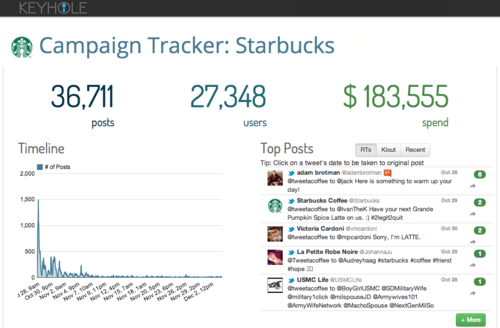
Brand Credibility
The campaign feel holds a sense of community, making the brand feel warm, inviting and generous. The new technology that they have created also suggests that Starbucks is up and coming, ahead of other coffee brands.
Personality
Being a coffee company, you would expect nothing less than the friendly, warm tone Starbucks delivers.
Responsive
Throughout the campaign Starbucks proved to be responsive and interactive with its audience, something that helped boost credibility and portray its inviting tone of voice.
Implementation
Technology And How Starbucks Will Measure Their Success
As these users continue to be customers, Starbucks now has a tie-in between the Twitter accounts, credit cards, mobile devices and their customer list (and they have it for 54,000 people gifters and recipients) which is something to be excited about!Even tech companies have struggled so far with creating a link between these different IDs for their customers, let alone consumer brands. This Starbucks campaign was about a lot more than just $180k in eGift sales. It was about customer understanding, identification and targeting that will help them for a very long time.
Few, So In Short, Was This Campaign Successful?
It’s clear to see that the ROI for this campaign alone wasn’t a huge success for Starbucks, with their total of $11million spent on digital media and a return of only $180, 000 from the Tweet-a-Coffee campaign, it seems that a few pockets have been left empty. However it hasn’t all been for nothing; the brand now has strong links with twitter, access to its online customer list plus access to their customer’s card details and mobile devices, a huge achievement that will provide them with knowledge they never had before. The campaign has also given Starbucks exposure online and enabled them to create a community and engagement centre for not only themselves but new and existing customers.
It’s not all ‘bean bitter’ after all!
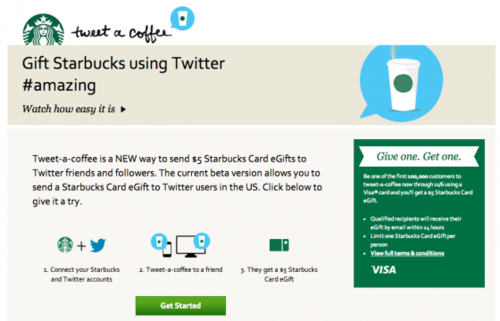
Related:
http://www.socialmediatoday.com/content/how-starbucks-crushes-it-social-media
https://www.starbucks.com/tweet-a-coffee
http://blog.keyhole.co/post/69080821142/starbucks-twitter-campaign
http://mashable.com/2013/12/05/starbuckss-tweet-a-coffee-180000/

